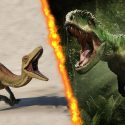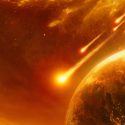Aliens?! Enchiladas?! What is this world coming to? Or should I say, what is coming to this world?
First of all, yes, it’s pronounced Enceladus (EN-CELL-A-DUSS), not enchiladas. Sorry, muchacho. Enceladus is Saturn’s sixth largest moon, but it would be better described as a winter wonderland.
Winter, because it’s covered in ice and has an average surface temperature of -200º C (-330º F). Wonder, because just 40 km (25 miles) below its surface, are the ingredients for life. Are there aliens out there? How long until we know for sure?
This is the Waimangu (Why-mang-goo) Geyser. It doesn’t exist anymore, but when it did, it could shoot water 460 meters (1,509 ft) high, making it the largest geyser ever known…on Earth. But beyond our atmosphere, Waimangu is a drop in the bucket.
If you want to see a real geyser, you should book a trip to Saturn. In September 2005, NASA’s billion dollar Cassini space probe was approaching Saturn, when it detected huge eruptions at the Southern pole of Enceladus. This tiny moon is roughly 25 times smaller than Earth, but its geysers are 8,000 times bigger than anything recorded on our planet. Cassini recorded bursts that went as far as 240 km (150 miles) into space – which is about the same distance as Washington D.C. to Philadelphia.
But if these bright plumes of mysterious vapor were a sight to behold, scientists were more in awe of what remained hidden. Beneath 40 km (25 miles) of thick ice, there is an ocean on Enceladus, and it’s remarkably similar to the oceans we have on Earth, where life might have begun.
The data collected by the Cassini space probe indicates that the water on Enceladus is salty, and is likely heated by hydrothermal vents. If Enceladus’ ocean works like our own, it’s expected that these subsurface vents expel hydrogen-rich hot water, which mixes with organic compounds to create amino acids, which combine to form proteins, the ingredients for life.
Our planet is estimated to be about 4.5 billion years old. The earliest evidence for life on Earth comes from fossils that were found in rocks that were roughly 3.7 billion years old.
Today, Enceladus is estimated to be about one billion years old, which, if it’s following an Earth-like timeline, would put it at the right age to start supporting life. But considering that for 90% of our planet’s history, life on Earth was microbial, chances are that alien life on Enceladus would also be microbial.
The big question is, what might these aliens look like? We’re talking about creatures formed in cold, dark water, with no access to sunlight. How would they interact with their environment?
Would they glow in the dark? Or would they see without eyes? How might they evolve? In size and in intelligence?
Will we ever find them? Or will they find us?
Subscribe to What-If on YouTube or follow the show on Facebook Watch.
Sources
- “Enceladus”. 2020. en.wikipedia.org.
- “What life might be like in alien oceans”. Tatalovic, Mico. 2020. bbc.com.
- “NASA Just Revealed An Ocean On Enceladus Contains The Building Blocks Of Life”. Sciencealert.
- “‘New Kinds Of Organic Compounds’ Found On Alien Moon, Says Nasa”. 2019. The Independent.
- “Enceladus”. 2020. NASA Solar System Exploration.
- “Cassini–Huygens”. 2020. en.wikipedia.org.
- “By The Numbers | Enceladus – NASA Solar System Exploration”. 2020. NASA Solar System Exploration.



























